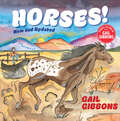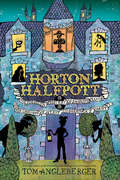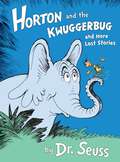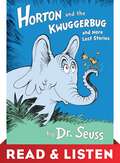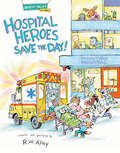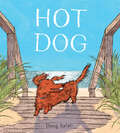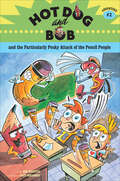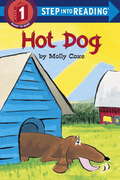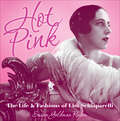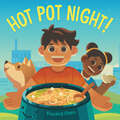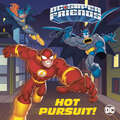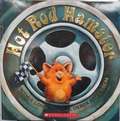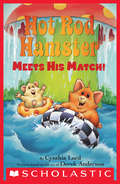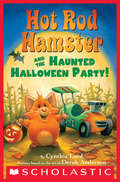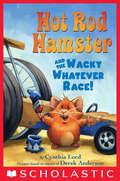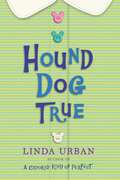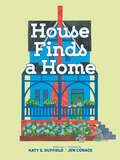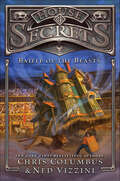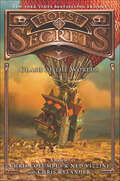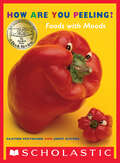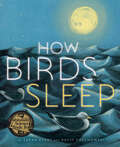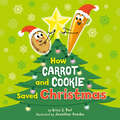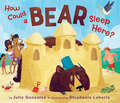- Table View
- List View
Horses! (New & Updated)
by Gail GibbonsFrom #1 science writer for kids Gail Gibbons, learn the latest facts about horses in this updated introduction to everyone&’s dream pet–the horse!No other animal has captured people's imaginations or changed their lives as has the horse. Their grace, strength, and beauty have made horses sought after as well as useful. What would kings and queens, knights and conquistadores, cowboys and stagecoach drivers, or farmers have done without them? Breeding horses was Queen Elizabeth II&’s favorite hobby. In this informative book, Gail Gibbons relates some of the long history that horses and humans have shared. She looks at horse biology and behavior. Learn about different horse breeds and how to take care of this majestic animal. Colorful, clear, and accessible diagrams are perfect for the youngest horse enthusiast.
Horton Halfpott: Or, The Fiendish Mystery of Smugwick Manor; or, The Loosening of M'Lady Luggertuck's Corset
by Tom AnglebergerA servant boy becomes an unlikely hero when a thief strikes in this humorous historical mystery by the author of The Strange Case of Origami Yoda. There are so many exciting things in this book—a Stolen Diamond, snooping stable boys, a famous detective, love, pickle éclairs—that it really does seem a shame to begin with ladies&’ underwear . . . It all starts when M&’Lady Luggertuck loosens her corset. As a result of &“the Loosening,&” all the strict rules around Smugwick Manor are abandoned. Shelves go undusted! Cake is eaten! Lunch is lukewarm! Then, when the precious family heirloom, the Luggertuck Lump (quite literally a lump), goes missing, the Luggertucks search for someone to blame. Could the thief really be Horton Halfpott, the good-natured but lowly kitchen boy who can&’t tell a lie? A colorful and hilarious cast comes together in this entertaining mystery, Tom Angleberger&’s loopiest novel yet!Praise for Horton Halfpott &“A positively gleeful historical mystery farce. . . . A satirical homage to Dickens by way of Pratchett and Snicket. Short chapters, a fast pace and plenty of linguistic and slapstistic humor will have young readers hoping that a sequel is planned. The scribbly pen-and-ink chapter-heading cartoon illustrations are just icing on the cake—or pickle éclair. A romp from start to finish.&” —Kirkus Reviews &“Angleberger delivers many spoonfuls of sugar alongside the moral of this Victorian fable.&” —Shelf-Awareness &“Readers are in for a treat.&” —Publishers Weekly
Horton and the Kwuggerbug and More Lost Stories (Classic Seuss)
by Dr. SeussA follow-up to The Bippolo Seed and Other Lost Stories by Dr. Seuss! A new Dr. Seuss book! This follow-up to The Bippolo Seed and Other Lost Stories features familiar Seussian faces and places—including Horton the Elephant, Marco, Mulberry Street, and a Grinch—as well as an introduction by renowned Seuss scholar Charles D. Cohen. Seuss fans will learn more about Horton&’s integrity, Marco&’s amazing imagination, a narrowly avoided disaster on Mullbery Street, and a devious Grinch. With a color palette enhanced beyond that of the magazines in which the stories originally appeared, this new volume of &“lost&” tales is a perfect gift for young readers and a must-have for Seuss collectors of all ages!
Horton and the Kwuggerbug and more Lost Stories: Read & Listen Edition (Classic Seuss)
by Dr. SeussA follow-up to The Bippolo Seed and Other Lost Stories by Dr. Seuss! A new Dr. Seuss book! This follow-up to The Bippolo Seed and Other Lost Stories features familiar Seussian faces and places—including Horton the Elephant, Marco, Mulberry Street, and a Grinch—as well as an introduction by renowned Seuss scholar Charles D. Cohen. Seuss fans will learn more about Horton&’s integrity, Marco&’s amazing imagination, a narrowly avoided disaster on Mullbery Street, and a devious Grinch. With a color palette enhanced beyond that of the magazines in which the stories originally appeared, this new volume of &“lost&” tales is a perfect gift for young readers and a must-have for Seuss collectors of all ages!This Read & Listen edition contains audio narration.
Hospital Heroes Save the Day! (Breezy Valley at Work)
by R.W. AlleyFor fans of Richard Scarry and Busytown, this funny and informative picture book set in a hospital features lively animals as doctors, nurses, and emergency workers in a rollicking story, with detail-packed illustrations.The hospital workers of the Breezy Valley Hospital are always ready to provide top-notch medical care to the residents of their beloved town. Doctors, nurses, lab workers, kitchen staff, and maintenance workers are just a few of the staff working to keep the hospital running smoothly. And when emergencies happen, the EMTs (Emergency Medical Technicians) and their ambulance come to the rescue—like when Lemur needed to be brought to the hospital to get treatment for their injured tail! Lively action, peeks into key hospital rooms, and more will keep young readers engaged in this second title in the Breezy Valley at Work series.
Hot Dog
by Doug SalatiFrom a critically acclaimed creator comes this summery picture book featuring an overheated—and overwhelmed—pup who finds his calm with some sea, sand, and fresh air. <P><P>It's summer in the city, and this hot dog has had enough! Enough of sizzling sidewalks, enough of wailing sirens, enough of people's feet right in his face. When he plops down in the middle of a crosswalk, his owner endeavors to get him the breath of fresh air he needs. She hails a taxi, hops a train, and ferries out to the beach. Here, a pup can run! <P><P>With fluid art and lyrical text that have the soothing effect of waves on sand, Doug Salati shows us how to find calm and carry it back with us so we can appreciate the small joys in a day. <p> <b>New York Times Bestseller</b> <P><P><i>Advisory: Bookshare has learned that this book offers only partial accessibility. We have kept it in the collection because it is useful for some of our members. Benetech is actively working on projects to improve accessibility issues such as these.</i>
Hot Dog and Bob and the Particularly Pesky Attack of the Pencil People
by L. Bob RovetchBeware the perilous pencils in the second novel of the wacky series starring a fifth-grade boy and &“a superhero in the form of a hot dog&” (School Library Journal). Be afraid of your pencil. Be VERY afraid! Just when Bob is getting over their last battle with the grossly evil pizza alien, he and Hot Dog have a new enemy to tackle: crafty little pencil snatchers from the planet Pencilvania. Beginning readers will be clamoring for Hot Dog and Bob&’s second adventure! Praise for the first Hot Dog and Bob adventure &“Those who relish the zaniest sort of slapstick will eat this up.&” —Publishers Weekly
Hot Dog: Step into Reading® 1 (Step into Reading)
by Molly CoxeA dog tries to find a way to cool off on a hot summer day on a farm
Hot Pink: The Life and Fashions of Elsa Schiaparelli
by Susan Goldman RubinShocking pink—hot pink, as it is called today—was the signature color of Elsa Schiaparelli (1890–1973) and perhaps her greatest contribution to the fashion world. Schiaparelli was one of the most innovative designers in the early 20th century. Many design elements that are taken for granted today she created and brought to the forefront of fashion. She is credited with many firsts: trompe l’oeil sweaters with collars and bows knitted in; wedge heels; shoulder bags; and even the concept of a runway show for presenting collections. Hot Pink—printed with a fifth color, hot pink!—explores Schiaparelli’s childhood in Rome, her introduction to high fashion in Paris, and her swift rise to success collaborating with surrealist and cubist artists like Salvador Dalí and Jean Cocteau. The book includes an author’s note, a list of museums and websites where you can find Schiaparelli’s fashions, endnotes, a bibliography, and an index.
Hot Pot Night!
by Vincent ChenHot pot, hot pot!Hits the right spot!What's for dinner? A Taiwanese American child brings his diverse neighbors together to make a tasty communal meal. Together, they cook up a steaming family dinner that celebrates community, cooperation, and culture. Includes a family recipe for hot pot! <P><P><i>Advisory: Bookshare has learned that this book offers only partial accessibility. We have kept it in the collection because it is useful for some of our members. Benetech is actively working on projects to improve accessibility issues such as these.</i>
Hot Pursuit! (Pictureback(R))
by Steve FoxeAn exciting full-color storybook featuring the DC Super Friends™—plus an eye-catching lenticular cover!The Joker and Lex Luthor team up to take down Batman™, Superman™, and the rest of the high-flying DC Super Friends™! Boys and girls ages 3 to 7 will love this action-packed DC Super Friends™ storybook which features an eye-catching lenticular cover that makes it appear as though the heroes are really racing to the rescue! DC Super Friends™ is a unique brand that gives preschoolers their very own versions of the World&’s Greatest Super Heroes from DC Comics: Superman™, Batman™, Wonder Woman™, Aquaman™, The Flash™, Cyborg™, Hawkman™, and Green Lantern™.
Hot Rod Hamster
by Cynthia Lord Derek AndersonNewbery Honor author Cynthia Lord and New York Times bestselling illustrator Derek Anderson put the pedal to the metal in this endearing, rhythmic, rip-roaring race to the finish line where a hamster creates a sizzling hot rod with a little help from his new furry friends and you!
Hot Rod Hamster Meets His Match! (Scholastic Reader, Level 2 #2)
by Cynthia LordThere's a new Hot Rod Hamster early reader from the dynamic duo of Newbery Honor author Cynthia Lord and New York Times bestselling illustrator Derek Anderson, and it's sure to make a splash!When Hamster and his friends go looking for some cool, wet, wild fun at the Water Kingdom waterpark, Hamster and his new friend, Holly, challenge two dogs to a race down the waterslide. Can they win?With the same bouncing rhythms, fun choice rhymes, and daredevil antics that made the picture books so popular, this original Level 2 reader will be a sturdy stepping-stone for both Hot Rod Hamster fans and series newcomers moving on to independent reading. The years Ms. Lord spent as a first-grade teacher have given her the perfect sense for what language and storylines work best for emerging readers. Little boys and girls will race to collect this latest story from their favorite furry friend.Speed down the early-reading water slide and join Hot Rod Hamster and his buddies for loads of fun in the sun!
Hot Rod Hamster and the Haunted Halloween Party! (Scholastic Reader, Level 2)
by Cynthia LordThe early reader series from the dynamic duo of Newbery Honor author Cynthia Lord and New York Times bestselling illustrator Derek Anderson now features Hot Rod Hamster in his spookiest adventure yet!It's Halloween and Hot Rod Hamster is going to a party! But first, he must come up with a costume that's fun and spooky enough to win the contest. Can you help him?With the same bouncing rhythms, fun choice rhymes, and daredevil antics that made the picture books so popular, this original Level 2 reader will be a sturdy stepping-stone for Hot Rod Hamster fans as well as series newcomers as they move on to independent reading. The years Ms. Lord spent as a first-grade teacher have given her the perfect sense for what language and storylines work best for emerging readers. This new adventure skillfully emphasizes word families and rhyming structures with pedal-to-the-metal flare! Little boys and girls will race to collect this latest story from their favorite furry friend.Hop into the early-reading driver's seat and join Hot Rod Hamster and his buddies for loads of spooky fun!
Hot Rod Hamster and the Wacky Whatever Race! (Scholastic Reader, Level 2)
by Cynthia LordA new early reader series from dynamic duo, Newbery Honor author Cynthia Lord and NEW YORK TIMES bestselling illustrator Derek Anderson, featuring Hot Rod Hamster!Hot Rod Hamster LOVES to drive superfast. And today he's building a box car from scratch to race downhill in the Wacky Whatever Race. He needs to pick out a box, wheels, and a paint color for his car. Can you help him?With the same bouncing rhythms, fun choice rhymes, and daredevil antics that made the picture books so popular, this original Level 2 reader will be a sturdy stepping-stone for Hot Rod Hamster fans as well as series newcomers as they move on to independent reading. The years Ms. Lord spent as a first-grade teacher have given her the perfect sense for what language and storylines work best for emerging readers. This new adventure skillfully emphasizes word families and rhyming structures with pedal-to-the-metal flare! Little boys and girls will race to collect this latest story from their favorite furry friend.Hop into the early-reading driver's seat and join Hot Rod Hamster and his buddies for a fun-filled race day with a thrilling surprise at the finish line!
Hound Dog True (Journeys 2014)
by Linda UrbanA story about small acts of courage from the author of A Crooked Kind of Perfect.Do not let a mop sit overnight in water. Fix things before they get too big for fixing. Custodial wisdom: Mattie Breen writes it all down. She has just one week to convince Uncle Potluck to take her on as his custodial apprentice at Mitchell P. Anderson Elementary School. One week until school starts and she has to be the new girl again. But if she can be Uncle Potluck&’s apprentice, she&’ll have important work to do during lunch and recess. Work that will keep her safely away from the other fifth graders. But when her custodial wisdom goes all wrong, Mattie&’s plan comes crashing down. And only then does she begin to see how one small, brave act can lead to a friend who is hound dog true.This ebook includes a sample chapter of THE CENTER OF EVERYTHING.
House Finds a Home
by Katy DuffieldReminiscent of the children&’s classic The Little House comes a picture book about a house and how the world changes both outside and inside of it over generations.House has always loved the people inside. When they move out, House&’s halls grow quiet, his windows dark. He hopes with all his shingles that there will be other inhabitants and joys to discover. As generations pass, House experiences new people and traditions and learns that love can come in many forms. Reminiscent of the beloved children&’s classic The Little House by Virginia Lee Burton, Katy S. Duffield&’s lyrical, heartwarming text and Jen Corace&’s exquisite illustrations bring warmth and vulnerability to the different ways a house becomes a home.
House of Secrets: Battle of the Beasts (House of Secrets Series #2)
by Ned Vizzini Chris ColumbusThe sequel to the New York Times bestselling House of Secrets—hailed by J. K. Rowling as "a breakneck, jam-packed roller coaster of an adventure"—this second installment by Hollywood director Chris Columbus (of Harry Potter fame) and bestselling author Ned Vizzini (It's Kind of a Funny Story) is full of even more explosive twists and turns.Since the siblings' last adventure, life in the Walker household is much improved—the family is rich and the Wind Witch is banished. But no Walker will be safe until she is found. Summoning her to San Francisco brings all the danger that comes with her, and puts the Walkers in the crosshairs of a mysterious journey through Denver Kristoff's books. As the Walkers travel from ancient Rome to World War II to Tibet, they are tested in ways that cut deeper than before—by Denver Kristoff, the Wind Witch, and one another.Fantasy fiction fans who enjoy Rick Riordan will find much to love in this thrilling and action-packed novel.
House of Secrets: Clash of the Worlds (House of Secrets Series #3)
by Ned Vizzini Chris Rylander Chris ColumbusThe final book in the New York Times bestselling House of Secrets series that was called “a breakneck, jam-packed roller coaster of an adventure” by J. K. Rowling. Created by Hollywood director Chris Columbus (of Harry Potter fame) and bestselling author Ned Vizzini (It’s Kind of a Funny Story), with the acclaimed author of the Codename Zero series and the Fourth Stall saga, Chris Rylander.With their last adventure just barely over, the Walker kids thought life would finally go back to normal. But things don’t remain calm for long . . . especially when the colossus Fat Jagger turns up in San Francisco Bay—and he’s in danger!With the police closing in, the Walkers must figure out how to save their giant friend. When a frost beast is spotted in Santa Rosa—and more mystical creatures start appearing all over America—it’s soon clear that the characters from Denver Kristoff’s works are invading the real world. It’s up to Brendan, Eleanor, and Cordelia to reenter the book world one last time to keep the worlds from colliding, causing mass destruction.They will have to track down three Worldkeepers hidden in Kristoff’s books—magical items that when used together will seal the worlds off for good. But the Walkers’ first move leads them straight into the Wild West, with lethal outlaws and lawless deputies—and that’s just the beginning. They’ll encounter dinosaurs, aliens, killer robots, and the Wind Witch herself—with new friends and old—and be faced with some of the deadliest choices they’ll ever have to make. The scariest thing of all could be deciding who to trust, since everyone is hiding something. . . .
How Animal Babies Stay Safe (Let's-Read-and-Find-Out Science 1)
by Mary Ann FraserRead and find out about how animal parents keep their babies safe from predators in this colorfully illustrated nonfiction picture book.This is a clear and appealing science book for early elementary age kids, both at home and in the classroom. It looks at the many strategies animal babies use to survive in a dangerous world. Some babies hide in nests or dens, some ride on thier parents' back or in their pouches, some use camouflage, and some rely on their parents' sharp claws and teeth to fend off enemies. Whether showing "a mother monkey swinging through the jungle with her baby on her back or two baby raccoons peeking out of their tree-house home while their mother lures a bobcat away from her young," wrote Kirkus, this book captures the eternal appeal of baby animals.It's a Level 1 Let's-Read-and-Find-Out, which means the book explores introductory concepts perfect for children in the primary grades. The 100+ titles in this leading nonfiction series are:hands-on and visualacclaimed and trustedgreat for classroomsTop 10 reasons to love LRFOs:Entertain and educate at the same timeHave appealing, child-centered topicsDevelopmentally appropriate for emerging readersFocused; answering questions instead of using survey approachEmploy engaging picture book quality illustrationsUse simple charts and graphics to improve visual literacy skillsFeature hands-on activities to engage young scientistsMeet national science education standardsWritten/illustrated by award-winning authors/illustrators & vetted by an expert in the fieldOver 130 titles in print, meeting a wide range of kids' scientific interestsBooks in this series support the Common Core Learning Standards, Next Generation Science Standards, and the Science, Technology, Engineering, and Math (STEM) standards. Let's-Read-and-Find-Out is the winner of the American Association for the Advancement of Science/Subaru Science Books & Films Prize for Outstanding Science Series.
How Are You Peeling? (Scholastic Bookshelf)
by Saxton Freymann Joost ElffersLet Scholastic Bookshelf be your guide through the whole range of your child's experiences-laugh with them, learn with them, read with them! Eight classic, best-selling titles are available now!Category: Feelings"Amused? Confused? Frustrated? Surprised? Try these feelings on for size."This is a book that asks all the right questions. And leaves you feeling great no matter what the answers are!"Who'd have dreamed that produce could be so expressive, so charming, so lively and so funny?...Freymann and...Elffers have created sweet and feisty little beings with feelings, passions, fears and an emotional range that is, well, organic."-The New York Times Book Review
How Are You, Verity?
by Meghan Wilson DuffA neurodivergent child interacts with their neighbors to discover the true meaning behind greetings and salutations. When people say &“How are you?&” are they really asking or just saying hello? Verity, who is neurodivergent, plans an experiment to figure this out. Verity is bubbling with excitement about an upcoming school field trip to the aquarium! When neighbors ask, &“How are you?&” Verity shares their excitement and fascinating facts about sea animals. Their older brother John kindly suggests that the question "How are you?" is actually a greeting and not an invitation to share so much. Verity plans an experiment to find out if their brother is right. But when the trip to the aquarium is cancelled, Verity is heartbroken. When people ask &“How are you?&” what should they say then?
How Birds Sleep
by David ObuchowskiDiscover the mysterious and fascinating sleeping habits of more than twenty bird species from around the world in this gorgeously illustrated read-aloud picture book, perfect for bedtime, or any time.Have you ever seen a bird sleep? Or wondered just when it is that migrating cranes find the time to catch Z&’s as they cross the ocean? From the parrots of Thailand to the ostriches of Australia and even the pigeons of New York City, every bird sleeps—but they do it in ways that will surprise and delight you. Some hang from tree branches, others doze while gliding, and some even burrow underground for a nap. Written in a witty, conversational voice, and with gorgeous illustrations, this picture book is bursting with interesting facts about this underexplored aspect of bird life all around us.
How Carrot and Cookie Saved Christmas
by Erica S. PerlA festive pun-filled story perfect for the holidays!In this follow-up to When Carrot Met Cookie, Christmas is fast approaching, and Carrot and Cookie are both worried—they can't find the right present for each other! But when they hear a crash on Christmas Eve and find a sick Santa too ill to keep flying his sleigh, they know there are more important matters at hand. Can these friends conjure up enough Christmas magic to step into Santa's shoes, deliver the presents themselves, and save the day? Hilarious and heartwarming, this is the perfect gift for future foodies or anyone looking for some special holiday cheer.
How Could a Bear Sleep Here?
by Julie GonzalezIt's time for Shelby to hibernate, but how could a bear sleep in this noisy forest?The woodpeckers are rat-tat-tatting, the squirrels are cracka-cracka-crunching--there's too much noise! When Shelby spies the perfect cave, only too late does he realize he's hopped aboard a tour bus bound for the beach.Coupled with hysterically expressive illustrations by Stephanie Laberis, Julie Gonzalez's lively text and familiar refrain sings as Shelby, after several attempts to snooze in the tropics with increasing exhaustion, finally discovers the perfect solution to his noise problem. This is a great read-aloud for young readers who will recognize the refrain ("How could a bear sleep here?") and the silliness of Shelby's predicament
